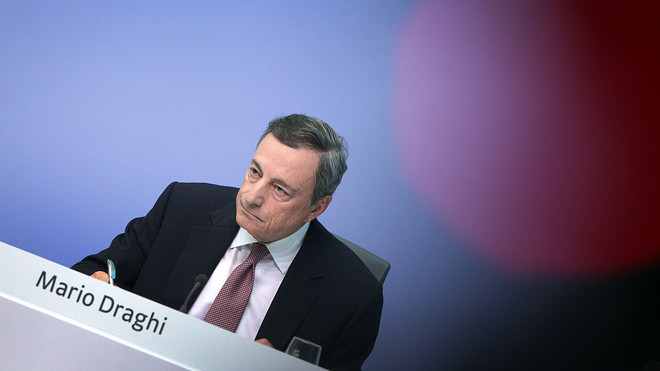 AFP/Getty Images
AFP/Getty Images
Over to you, Mario Draghi.
After hints of a potential rate cut by Federal Reserve Chairman Jerome Powell and indications that easier policy may be in the offing by Australia’s top monetary policy maker earlier this week, the European Central Bank president is also widely expected to maintain a dovish stance in his postmeeting news conference on Thursday.
That could serve to keep pressure on the euro EURUSD, +0.0802% analysts said. The shared currency was off 0.2% on Wednesday to trade near $1.1228 and remains off more than 2% so far in 2019 versus the dollar.
“Markets seem to already expect a dovish ECB meeting based on our recent discussions with investors, although more in terms of the tone than policy action,” wrote currency analysts at Bank of America Merrill Lynch in a Wednesday note. “ We think Draghi should feel comfortable with the weak EUR level, but his dovish tone and threats for more policy loosening measures, if necessary, could still be negative for the EUR.”
The ECB has pledged to leave interest rates at present levels at least through the end of 2019.
Here’s a look at what economists and investors will be watching for when the ECB concludes the two-day meeting taking place in the Lithuanian capital of Vilnius — one of two meetings the central bank holds outside its Frankfurt headquarters each year.
TLTRO
Five letters will likely get a lot of attention. The ECB is widely expected to finally offer details of the third iteration of its targeted long-term refinancing operations, or TLTROs. The acronym may be clunky, but the program, which is designed to keep the credit spigots to eurozone companies open in the face of an economic slowdown and inflation that remains well below the ECB’s target, is important.
The ECB announced it would deliver another round of TLTROs in March, but has held off on crucial details that investors and economists will use to judge just how aggressively the ECB is moving to stimulate the eurozone economy.
“We expect TLTRO3 to be slightly less generous than TLTRO2, but the ECB may also feel the need to take out additional insurance on liquidity at the current juncture by surprising with a generous TLTRO3,” said Anatoli Annenkov, economist at Société Générale, in a note.
The decision to launch another program was seen as an about-face from the tightening mode that had characterized ECB policy in 2018 as it wound down the bond-buying program that had been at the heart of its quantitative-easing effort.
Under the TLTRO program, banks receive cheap, long-term loans. The “targeted” part of the name refers to the requirement that banks in turn boost lending to the real economy. If they do, they’re effectively paid to lend, with banks that participated in the TLTRO2 program potentially being compensated at the ECB’s deposit rate of minus 0.4%.
Just how generous the ECB aims to be in its third round will be closely watched.
Market participants “are likely to judge Draghi’s ‘dovishness’ simply based on whether the floor that could be reached is indeed -0.40%, or something higher, which is what the ECB ‘sources’ seemed to be hinting at a few months back,” said Marchel Alexandrovich, senior European economist at Jefferies, in a note. “Whatever the initial headlines, however, as ever with the ECB, the devil of what’s really being offered will be in the detail.”
Forecasts
Investors will also be paying close attention to ECB staff forecasts on the economic outlook and inflation.
The ECB is likely overly pessimistic on its outlook for near-term growth but overly optimistic for 202, said George Buckley, economist at Nomura, in a note. He expects the ECB to forecast 2019 gross domestic product to grow 1.2% in 2019, up from a March estimate of 1.1%, while forecasts for growth of 1.6% in 2020 and 1.5% in 2021 remain unchanged.
He also looks for the ECB to raise its 2019 inflation forecast to 1.3% from 1.2%, while maintaining forecasts for 1.5% in 2020 and 1.6% in 2021 — remaining well below the ECB’s target of near but just below 2%.
Of particular importance to investors, however, may be whether the ECB keeps its estimate of 2021 core inflation forecast unchanged at 1.6%, said Alexandrovich, noting that the figure is particularly interesting given that the estimates are the first forecasts to be prepared under the ECB’s new chief economist, Philip Lane, who replaced Peter Praet at the beginning of the month.
Rate tiering
The ECB’s negative deposit rate at minus 0.4% has long been a source of unease. Critics fear the rate on deposits parked overnight at the central bank, when in negative territory, saps the health of banks and impedes lending.
There has been speculation the ECB could eventually move to introduce a tiered system that would exempt a portion of the banking system’s excess reserves from negative rates. But many economists argue it’s still unlikley.
Buckley said a move to tiered rates runs the risk of sending a “wrong message,” leaving investors with the notion that the ECB intends to keep deposit rates “at very low levels for some considerable time (which in turn would flatten the curve, making the plight of European banks even worse).”






